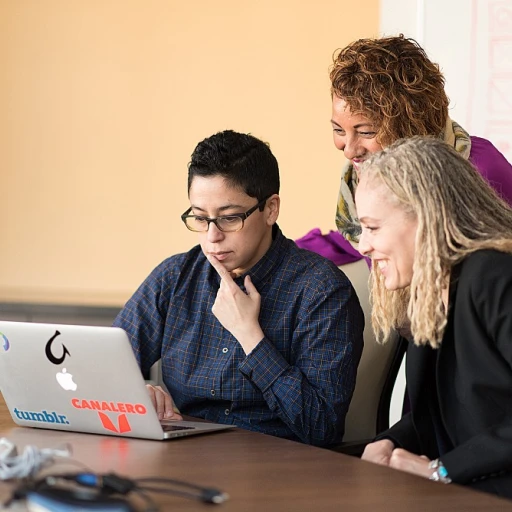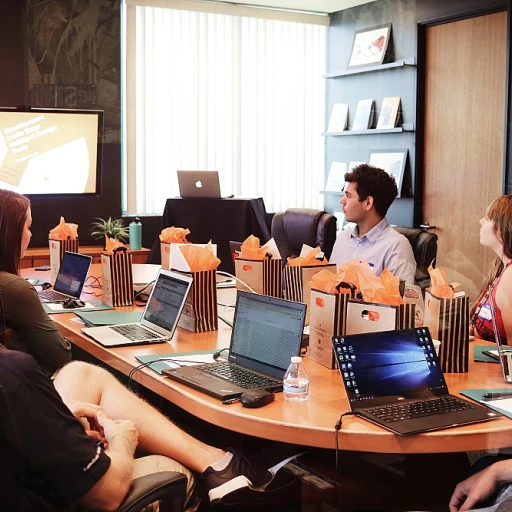
Understanding Ageism: A Barrier to Career Transitions
Ageism as a Roadblock in Career Transitions
Navigating a career transition can be challenging, especially when ageism becomes an obstacle. Age discrimination in the workplace is a significant issue that affects many older employees striving to move ahead or pivot in their careers. It's essential to understand how these barriers manifest and why they are detrimental to career development. Ageism refers to the prejudices and discrimination based on a person's age. In professional settings, this often means older workers face negative stereotypes and assumptions that can hinder their growth opportunities. Employers sometimes presume that older employees are less adaptable or unwilling to learn new skills compared to their younger counterparts, which contributes to a discriminatory workplace environment. The bias against aging workforce isn't just a matter of perception. A study by the AARP revealed that approximately 61% of older workers reported experiencing or witnessing age-related discrimination at work. Such experiences highlight the need for awareness and proactive measures to ensure equitable treatment across employees ages in the workforce. One critical aspect of addressing ageism is understanding the misconceptions surrounding older individuals in the job market. For example, there is a common but unfounded belief that older employees have lower performance levels or that they're more likely to leave work due to retirement age. Contrary to these beliefs, many older workers are now postponing retirement and often bring valuable experience and expertise to their roles, enriching the workplace environment. As employees age, employers must recognize the value that this age group brings. Many companies are starting to realize the benefits of having a multi-generational workforce, as it fosters a more dynamic and innovative work culture. The key for older workers is to challenge these stereotypes by emphasizing their skillsets, experience, and willingness to adapt to change. Combatting ageism in the workplace requires a multi-faceted approach, including raising awareness of age-based discrimination and implementing strong workplace policies. This effort is not just about improving opportunities for older employees but also about creating a more inclusive work environment for all ages. For those considering a career change, understanding the landscape of ageism and knowing your rights in employment can empower you to make informed decisions. If you are contemplating a shift in your career path and are in your 50s, you might find valuable insights on navigating your career change journey at navigating a career change in your 50s.Common Examples of Ageism in the Workplace
Frequent Manifestations of Age-Based Discrimination in Employment
Ageism in the workplace can take many insidious forms that might not always be evident at first glance. This type of discrimination often reflects deeply ingrained stereotypes and biases that place older workers at a disadvantage compared to their younger counterparts. Recognizing these subtleties is pivotal to understanding how they may affect your career transitions.Here are some common occurrences of age-based discrimination in employment, which can hinder older employees' professional journeys:
- Job Advertisements: Some job postings explicitly or implicitly favor younger candidates by using terms such as "digital native" or "recent graduate." This rhetoric can discourage older candidates from applying.
- Training and Development Opportunities: Employers may assume that older workers are not interested in or capable of learning new skills, thereby offering fewer training opportunities to this age group.
- Promotion Bias: Ageism can influence promotions, with older employees being overlooked for advancement opportunities in favor of younger, less experienced colleagues.
- Performance and Evaluation: Performance reviews can sometimes be skewed, with older workers facing more critical evaluations without concrete evidence. Assumptions about reduced performance or adaptability based on age are forms of discrimination workplace issues.
- Layoffs and Redundancies: In some cases, older workers are targeted for layoffs to reduce salary costs, taking advantage of the retirement age assumption.
Understanding these examples can equip you to identify potential age discrimination and take proactive measures to address them. Navigating a career change in your 40s, for instance, may require extra vigilance and strategic planning to counteract these biases and spotlight your unique skills and experiences.
Impact of Ageism on Career Development
Impact of Ageism on Career Progression
Ageism is a profound issue that has significant repercussions for career development. It affects the professional growth and advancement opportunities of older workers in numerous ways. As our workplace dynamics continue to evolve, understanding this impact becomes crucial. The perception of age can taint an employer's view of an individual's capabilities. Many older employees find themselves hindered by a workplace bias that favors younger employees. Despite possession of ample experience and a proven track record of performance, older workers often face difficulties securing promotions, new roles, or even retaining their jobs. This bias is not solely based on performance but also on stereotypes about employees' ages. Additionally, the pervasive nature of age discrimination can cause older employees to feel undervalued. This not only affects their confidence but can also lead to decreased job satisfaction or even retirement before they are ready. Age-based assumptions can overshadow the rich contributions these experienced workers bring to a company. Moreover, age discrimination in the workplace stands as a barrier for older people seeking new employment opportunities. Many employers may be influenced by misconceptions that older workers lack adaptability to new technologies or fear they will demand higher salaries due to their experience. Consequently, this limits the occupational mobility and reemployment prospects for experienced professionals. Indeed, such workplace discrimination is a hurdle for those attempting to transition into a new role or industry. To effectively address these challenges, organizations should prioritize creating an inclusive environment. This involves implementing fair assessment criteria, enforcing age discrimination laws, and fostering a culture where all age groups are respected and valued. To gain further insights into addressing workplace issues effectively, referring to how employee climate surveys can enhance career transitions could be beneficial.Legal Protections Against Ageism
Legal Safeguards for Older Employees
In the battle against ageism in the workplace, understanding legal protections is crucial for safeguarding the rights of older employees. Discrimination based on age is a pervasive issue, but fortunately, legislation exists to protect these individuals from unfair treatment. The cornerstone of age-related legal protection in many regions is the Age Discrimination in Employment Act (ADEA). This law helps shield workers aged 40 and older from discrimination in hiring, promotion, termination, and other aspects of employment based on age.
Key Legislative Measures
Apart from the ADEA, various countries and states have enacted their own regulations to combat age-based bias. These laws aim to create a level playing field for both younger and older employees, ensuring that performance and qualifications—not age—determine employment opportunities. It’s vital for both employees and employers to familiarize themselves with the specific provisions applicable in their jurisdiction to avoid legal pitfalls and foster an inclusive work environment.
Employer Responsibilities
Employers hold a significant responsibility in maintaining a fair workplace. It is their duty to be aware of workplace discrimination and to implement practices that prevent ageism. This includes reviewing job descriptions to ensure they do not deter older workers, promoting workplace diversity, and providing training to help managers recognize and eliminate ageist attitudes. Through proactive measures, companies can not only comply with employment law but also benefit from the diverse perspectives and experiences that older employees contribute.
Empowering Employees to Stand-Up Against Discrimination
For older people facing discrimination in the workplace, knowing their rights is the first step toward empowerment. These employees should document instances of ageism and seek advice from human resources or legal professionals if necessary. Additionally, organizations are encouraged to establish clear policies for reporting discrimination, ensuring that all employees can work without fear of biased treatment based on their age.
Strategies to Combat Ageism During Career Transitions
Navigating the Obstacle Course: Practical Steps to Mitigate Ageism in Job Changes
When considering a career transition, ageism can often feel like a significant hurdle. However, there are strategic actions older workers can take to combat age discrimination.- Showcase Experience and Skills: Highlighting your extensive work experience and unique skill set is crucial. Employers value expertise and capabilities that come from years of service. Develop a portfolio that demonstrates successful past projects and initiatives, focusing on the added value your experience brings to a potential new employer.
- Stay Relevant: A continuous learning approach signals adaptability and an up-to-date skill set. Use online courses, workshops, or certifications to learn new technologies and industry trends pertinent to your field. This not only enhances your resume but also shows prospective employers that you are proactive and future-focused.
- Network Strategically: Building relationships across various age groups in the workplace can open doors to new opportunities. Attend industry events, join professional groups, and network with both older and younger employees to expand your reach within the employment sphere.
- Consider Legal Protections: Familiarize yourself with age discrimination laws in your region. Understanding your rights related to age-based employment discrimination work can arm you with the knowledge needed to protect yourself. These laws can serve as a safety net and give you the confidence to navigate employment challenges.
- Promote a Learning Culture: Encourage open dialogue and mentorship within the workplace. Retain relevance by facilitating a culture where experiences are shared, and different employees' ages learn from each other. This approach can help dismantle stereotypes about older employees being resistant to change.
- Craft a Positive Personal Brand: Utilizing platforms like LinkedIn to share insights, achievements, and ongoing projects can create a digital presence that emphasizes a proactive, knowledgeable, and vibrant professional image.
- Mentorship Opportunities: Older employees can engage in mentorship programs, providing guidance to younger employees while also learning new perspectives and ideas. This bi-directional exchange enriches workplace culture and fosters inclusivity.
Success Stories: Overcoming Ageism in Career Transitions
Triumphs Over Age Bias: Real Stories
Navigating the challenging terrain of age discrimination in the employment sector requires determination and strategic thinking. Older workers often face hurdles as they attempt to shift career paths. However, several examples offer inspiration and motivation—cases where individuals have effectively countered age bias to successfully transition careers.- Leveraging Experience: One common success factor is turning what might be perceived as disadvantages—like longer sector experience—into strengths. Some employees have managed to highlight their extensive experience as a vital asset to their new employers, who may be younger and in need of guidance and mentorship in their work environments. This transition can showcase how valuing diverse employee ages enriches workplace dynamics and enhances company performance.
- Embracing Continuous Learning: Older employees who have overcome age discrimination often embrace continuous learning, keeping skills sharp and relevant. Staying updated with modern technologies and work practices dispels stereotypes about older people being resistant to change, thereby favorably positioning them in age-diverse workplace contexts.
- Networking with Intention: Building genuine professional connections across age groups within the workplace can help bridge the gap between older and younger employees. Networking practices that include attending industry events or engaging in professional communities often lead to job opportunities and broaden employment possibilities, evidenced by multiple case studies from seasoned employees.
- Advocacy and Persistence: Real-world examples show that understanding employment law can also play a crucial role. Knowledgeable workers advocate for themselves and others, challenging discriminatory practices based on age. Their persistence in seeking fair treatment based on merit, rather than age, can shift workplace culture in a more inclusive direction.












